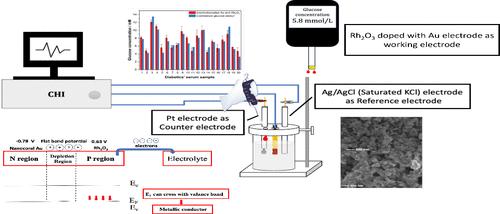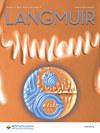Schottky Interface Enabled Electrospun Rhodium Oxide Doped Gold for Both pH Sensing and Glucose Measurements in Neutral Buffer and Human Serum
IF 3.7
2区 化学
Q2 CHEMISTRY, MULTIDISCIPLINARY
引用次数: 0
Abstract
This study has focused on adjusting sensing environment from basic to neutral pH and improve sensing performance by doping electrodeposited gold (Au) with metal oxide for nonenzymatic glucose measurements in forming a Schottky interface for superior glucose sensing with detailed analysis for the sensing mechanism. The prepared sensor also holds the ability to measure pH with the identical electrospun metal oxide-electrodeposited Au, which composed a dual sensor (glucose and pH sensor) through applying chronoamperometry and open circuit potential methods. The rhodium oxide nanocoral structure was fabricated with an electrospinning precursor solution, followed by a calcination process, and it was mixed with electrodeposited nanocoral gold to form the Schottky interface by constructing a p-n type heterogeneous junction for improved sensitivity in glucose detection. The prepared materials were characterized by X-ray powder diffraction (XRD), scanning electron microscopy (SEM), transmission electron microscopy (TEM), and X-ray photoelectron spectrometry (XPS), etc. The prepared materials were used for both pH responsive testing and amperometric glucose measurements. The rhodium oxide nanocoral doped gold demonstrated a sensitivity of 3.52 μA mM–1 cm–2 and limit of detection of 20 μM with linear range up to 3 mM glucose concentration compared to solely electrodeposited gold for a sensitivity of 0.46 μA mM–1 cm–2 and a limit of detection of 450 μM. The Mott–Schottky method was used for the analysis of an electron transfer process from noble metal to metal oxide to electrolyte in demonstrating the improved sensitivity at neutral pH for glucose measurements due to the Schottky barrier adjustment mechanism at an applied flat band potential of 0.3 V. This work opens a new venue in illustrating the metal oxide/metal materials in the glucose neutral response mechanism. In the end, human serum samples were tested against current commercial glucose meter to certify the accuracy of the proposed sensor.

肖特基界面支持电纺氧化铑掺杂金,用于中性缓冲液和人体血清中的 pH 传感和葡萄糖测量
本研究的重点是通过在电沉积金(Au)中掺入金属氧化物来调整传感环境,使其从碱性pH值到中性pH值,并通过详细分析传感机理,在形成肖特基界面的非酶葡萄糖测量中提高传感性能,从而实现卓越的葡萄糖传感。所制备的传感器还具有与相同的电纺金属氧化物-电沉积金测量 pH 值的能力,通过应用时标法和开路电位法,该传感器构成了双重传感器(葡萄糖和 pH 值传感器)。氧化铑纳米珊瑚结构是用电纺丝前体溶液制成的,然后经过煅烧过程,与电沉积纳米珊瑚金混合,通过构建 p-n 型异质结形成肖特基界面,从而提高葡萄糖检测的灵敏度。制备的材料通过 X 射线粉末衍射(XRD)、扫描电子显微镜(SEM)、透射电子显微镜(TEM)和 X 射线光电子能谱(XPS)等进行了表征。制备的材料被用于 pH 响应测试和安培葡萄糖测量。掺杂氧化铑纳米珊瑚的金的灵敏度为 3.52 μA mM-1 cm-2,检测限为 20 μM,线性范围可达 3 mM 葡萄糖浓度,而单纯电沉积金的灵敏度为 0.46 μA mM-1 cm-2,检测限为 450 μM。这项研究采用 Mott-Schottky 方法分析了从贵金属到金属氧化物再到电解质的电子传递过程,结果表明,在 0.3 V 的平带电位下,由于肖特基势垒调整机制的作用,葡萄糖测量在中性 pH 值下的灵敏度得到了提高。最后,还用目前的商用血糖仪测试了人体血清样本,以证明所提出的传感器的准确性。
本文章由计算机程序翻译,如有差异,请以英文原文为准。
求助全文
约1分钟内获得全文
求助全文
来源期刊

Langmuir
化学-材料科学:综合
CiteScore
6.50
自引率
10.30%
发文量
1464
审稿时长
2.1 months
期刊介绍:
Langmuir is an interdisciplinary journal publishing articles in the following subject categories:
Colloids: surfactants and self-assembly, dispersions, emulsions, foams
Interfaces: adsorption, reactions, films, forces
Biological Interfaces: biocolloids, biomolecular and biomimetic materials
Materials: nano- and mesostructured materials, polymers, gels, liquid crystals
Electrochemistry: interfacial charge transfer, charge transport, electrocatalysis, electrokinetic phenomena, bioelectrochemistry
Devices and Applications: sensors, fluidics, patterning, catalysis, photonic crystals
However, when high-impact, original work is submitted that does not fit within the above categories, decisions to accept or decline such papers will be based on one criteria: What Would Irving Do?
Langmuir ranks #2 in citations out of 136 journals in the category of Physical Chemistry with 113,157 total citations. The journal received an Impact Factor of 4.384*.
This journal is also indexed in the categories of Materials Science (ranked #1) and Multidisciplinary Chemistry (ranked #5).
 求助内容:
求助内容: 应助结果提醒方式:
应助结果提醒方式:


